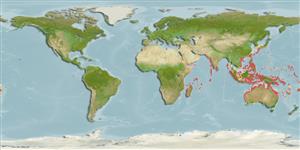>
Gobiiformes (Gobies) >
Gobiidae (Gobies) > Gobiinae
Etymology: Fusigobius: Latin, fusus = spindle + Latin, gobius = gudgeon (Ref. 45335); maximus: Named for being the largest among its congeners..
More on author: Randall.
Environment: milieu / climate zone / depth range / distribution range
Ecologia
marino demersale; distribuzione batimetrica 3 - 21 m (Ref. 41649). Tropical
Indo-West Pacific: Red Sea, Sri Lanka, Indonesia, Philippines and the Coral Sea.
Size / Peso / Age
Maturity: Lm ? range ? - ? cm
Max length : 7.5 cm SL maschio/sesso non determinato; (Ref. 41649); 6.9 cm SL (female)
Short description
Morfologia | Morfometria
Spine dorsali (totale): 6 - 7; Raggi dorsali molli (totale): 9; Spine anali 1; Raggi anali molli: 8. Characterized by semi-translucent body with dusky orange-yellow spots on head, body, dorsal and caudal fins; first membrane of dorsal fin with vertically elongate black spot; black spot at midbase of caudal fin; fully united pelvic fins; presence of pelvic frenum; rounded caudal fin; longitudinal scale series 26-27; ctenoid scales except cycloid on breast, base of pectoral fin and anteroventrally on abdomen; absence of scales on operculum; median predorsal scales absent, but scales on side of nape extending to above rear edge of preopercle; opening of gill extending to within one-fifth opercle width from posterior edge of preopercle; depth of body 4.7-5.5 in SL (Ref. 90102).
Inhabits sand-rubble bottoms near reefs in 3-21 m (Ref. 90102).
Life cycle and mating behavior
Maturità | Riproduzione | Deposizione | Uova | Fecundity | Larve
Randall, J.E., 2001. Five new Indo-Pacific gobiid fishes of the genus Coryphopterus. Zool. Stud. 40(3):206-225. (Ref. 41649)
IUCN Red List Status (Ref. 130435)
Threat to humans
Harmless
Human uses
Informazioni ulteriori
Nomi ComuniSinonimiMetabolismoPredatoriEcotossicologiaRiproduzioneMaturitàDeposizioneSpawning aggregationFecundityUovaEgg development
Age/SizeAccrescimentoLength-weightLength-lengthLength-frequenciesMorfometriaMorfologiaLarveDinamica popolazioni larvaliReclutamentoAbbondanzaBRUVS
BibliografiaAcquacolturaProfilo di acquacolturaVarietàGeneticaElectrophoresesEreditarietàMalattieElaborazioneNutrientsMass conversion
CollaboratoriImmaginiStamps, Coins Misc.SuoniCiguateraVelocitàModalità di nuotoArea branchialeOtolithsCervelliVista
Strumenti
Special reports
Download XML
Fonti Internet
Estimates based on models
Preferred temperature (Ref.
123201): 24.7 - 29.3, mean 28.4 °C (based on 2629 cells).
Phylogenetic diversity index (Ref.
82804): PD
50 = 0.5005 [Uniqueness, from 0.5 = low to 2.0 = high].
Bayesian length-weight: a=0.00708 (0.00333 - 0.01504), b=3.09 (2.92 - 3.26), in cm total length, based on LWR estimates for this (Sub)family-body shape (Ref.
93245).
Trophic level (Ref.
69278): 3.3 ±0.4 se; based on size and trophs of closest relatives
Resilienza (Ref.
120179): Alto, tempo minimo di raddoppiamento della popolazione meno di 15 mesi (Preliminary K or Fecundity.).
Fishing Vulnerability (Ref.
59153): Low vulnerability (10 of 100).
Nutrients (Ref.
124155): Calcium = 461 [239, 1,105] mg/100g; Iron = 1.55 [0.82, 3.09] mg/100g; Protein = 17.1 [15.2, 18.7] %; Omega3 = 0.152 [0.060, 0.323] g/100g; Selenium = 35 [16, 80] μg/100g; VitaminA = 39.1 [10.6, 138.0] μg/100g; Zinc = 2.26 [1.49, 3.46] mg/100g (wet weight);
